Body fat percentage. What is the normal percentage of body fat for health?
Anyone who has been even slightly interested in a healthy way life and weight loss knows that a big role for appearance plays exactly body fat percentage. The fashion for a curvaceous figure has passed for a long time and, by modern standards, beauty lies in a slim, fit, athletic body. Accordingly, the lower its percentage in the body, the more aesthetically pleasing a person looks.
But here, too, there are norms, neglecting which you risk getting obesity or anorexia instead of beauty. Also, maintaining body fat within normal limits is extremely important for health. Deviations in one direction or another can lead to disastrous consequences, sometimes even irreparable. The fat layer is accumulated not only on muscle tissue, but also on internal organs, which is especially dangerous. You've probably heard the concept of “visceral fat.” So what is the optimal body fat content? How to properly reduce its percentage and not harm your health? Where is the line between beautiful slimness and excessive thinness and where can you “get” the desired relief? To understand how to determine the percentage of body fat and find out the answers to the questions, read the information below.
If you have overweight body and the naked eye can see that the percentage of fat is higher than normal, then you do not need accurate measurements. They are necessary for athletes who carefully control their nutrition and exercise. It is difficult for them to determine something “by eye”.
There are many methods for determining its percentage in the body, but, unfortunately, not all of them are accurate:
- caliper - a specialized device with a scale - has a high error;
- X-ray - minimal deviations;
- special scales and other gadgets - the error is about 6% (highly dependent on the current state of the body);
- bioelectric resistance - there is also an error;
- “by eye” - the error is large, but the method is the simplest and most common.
Let's look at each in a little more detail. The caliper measures the thickness of the skin in the fat fold. Measurements are taken in several places, and then the results are summed up and applied to several equations. Disadvantages of this method: the equations are not accurate initially, clamping less skin you will get an underestimated result, and if you press more, you will get an overestimated result. So you won’t be able to calculate the correct coefficient. X-ray has a smaller error than the previous method, but is still not accurate, this has already been proven by a number of studies. Moreover, a lot depends on the device itself, the condition of the body, gender, weight and many other factors. The error ranges from 4 to 10%. The most accurate method for determining your body fat percentage is the four-section test.
Here the body is conventionally divided into four components:
- bones;
- water;
- muscles;
- adipose tissue.
All this is individually “weighed”, and the results are passed through a special formula. This method will help you reliably calculate your body fat percentage for women and men. If you judge by eye, a sculpted body contains about 10% fat, while a slender, non-sculpted body contains up to 20%. Well, if there is obesity at any stage, then it’s no less than 50%.
Practical advice: When determining the percentage using this method, you need to remember the role of muscle mass. The same indicator will be for a “jock” and a thin one. The only difference is the relief.
Body fat calculator
Result: Your body contains approximately fat (or ).
What is the minimum fat percentage
It is completely impossible to get rid of the fat layer, since it is also necessary for normal operation organism.
Please note: For men, the minimum content is considered to be 5%, for women - 13%. If the percentage is lower than normal, a refusal will follow. internal organs.
There is such a case in history. A bodybuilder who overdid it with getting rid of fat has died. A small part of the fat is and should be in all human organs and systems.
In addition to it, there are 2 more types:
- subcutaneous;
- visceral.
The latter accumulates on the internal organs and it is more difficult to get rid of it. A small amount of fat is provided for the normal functioning of the body, but its excess leads to many serious diseases.
Normal (healthy) body fat percentage
Completeness cannot be healthy by definition. The World Health Organization has a chart that indicates a healthy fat percentage.
| Men | ||||
| Age | Short % | Healthy % | High % | Obesity |
| 20-40 years | Below 8 | 9-19% | 20-25 | Above 25 |
| 41-60 years | Below 11 | 12-22% | 23-27 | Above 27 |
| 61-79 years old | Below 13 | 14-25% | 26-30 | Above 30 |
| Women | ||||
| Age | Short % | Healthy % | High % | Obesity |
| 20-40 years | Below 21 | 21-33% | 33-39 | Above 39 |
| 41-60 years | Below 23 | 23-35% | 35-40 | Above 40 |
| 61-79 years old | Below 24 | 24-36% | 36-42 | Above 42 |
As mentioned earlier, a low content of subcutaneous (and not only) fiber leads to death, and a high content leads to many diseases. There is a norm of body fat content and it should be adhered to.
Visceral fat
For a long time, the accumulation of visceral fat in adults was attributed to genetics - predisposition and so on. But scientists have proven that a fat woman is not to blame for your obesity. The content of visceral fat increases along with subcutaneous fat, and genetics have nothing to do with it.
It becomes harmful when contained:
- for men from 20%;
- in women from 40%.
Reducing body fat percentage
Losing weight is a difficult task, but it can be done. In the first couple of kilograms you lose faster than the last few. At first glance, everything is simple - you need to eat less (kcal) than you spend. This is how the body begins to take energy from fat reserves, burning them. But the slimmer you become, the harder it is to lose a few extra pounds.
Please note: The greater the initial body weight (fat), the faster it goes away from the first weeks of training. Further more difficult. As fat mass decreases, more and more effort is required to achieve the next result.
For example, the initial weight is 100 kg. During the first month of training and proper nutrition you can lose 5-10 kg. In the second month, 3-7 kg are lost under the same loads, and so on. Therefore, you need to increase the load as the weight decreases. An experienced trainer can help you choose the right initial and further exercises, and it is better to consult a nutritionist when choosing a diet. The percentage of body fat, both when losing weight and when playing professional sports, is more important than calculating BMI (body mass index). The latter only shows the ratio of height and weight; there are even calculators to calculate it. But for a full assessment physical development This is not enough.
What to do to get the desired relief
When losing weight, it is important not only to get rid of fat, but also to achieve toned and defined muscles, even if not very pronounced. Below are guidelines on what you should and shouldn't do every day to move from one "fat category" to another.
| % fat in men | % fat in women | What to do | Restrictions |
| From 20 | From 30 | To dial: there are semi-finished products; large portions; consume food quickly |
News sedentary lifestyle life; eat little fruits, vegetables and other healthy foods; do not keep a balanced diet; sleep as little as possible. |
| 15-20 | 25-30 | +2 servings of food with big amount protein a day; + 2 small servings of vegetables; workouts or active activities 3-5 times a week |
Reduce the amount of (slightly) processed carbohydrates; Consume slightly less high-calorie drinks. |
| 13-15 | 23-25 | Add protein to 2-3 meals per day; +3 servings of vegetables per day; activity 45 minutes a day; 1-2 workouts per week; sleep 7 hours a day; fight stress. |
Desserts up to 3-5 times a week; drinks with a lot of calories 3-5 times a week. |
| 10 - 12 | 20-22 | Take full control of your diet; protein and vegetables 1 serving daily; + small quantity fatty acids omega 3; + some processed carbohydrates; 50 minutes of activity every day; 4 workouts per week; sleep at least 8 hours; fight stress. |
Desserts no more than 1-2 times a week; 1-2 high-calorie drinks per week, no more. |
| 6 - 9 | 16 - 19 | Full power control; + protein, vegetables, healthy fats; calorie/carbohydrate cycling; activity 75 minutes every day; 4-5 training sessions per week; sleep 8-9 hours; fight stress. |
Carbohydrates only on special days; desserts up to 2 times a week; up to 1 high-calorie drink per week; restaurants up to 2 times a week. |
Conclusion
A normal percentage of fat requires constant maintenance: proper nutrition, physical activity. Indicators above normal can lead to many diseases, including diabetes, problems with the heart muscle and the whole vascular system, joint diseases and so on. List possible complications too long.
Regular determination of body fat percentage - The best way assessing the effectiveness of diet or fat-burning training. The usual number on the scale and weight in kilograms can distort the real situation, since during the period of weight loss the body tends to replace part of the lost fat with water.
There are many methods for calculating body fat percentage, but most of them have very limited high level errors. It is recommended to trust only professional methods - if a cheap floor scale shows that you have 2% body fat, this does not mean anything.
Ideal fat level
For men, 6-13 percent body fat means a toned, athletic physique and fairly defined abs, 14-17% means good physical shape with a small amount of fat in problem areas, 18-25% means average level forms, above 25% - obesity.
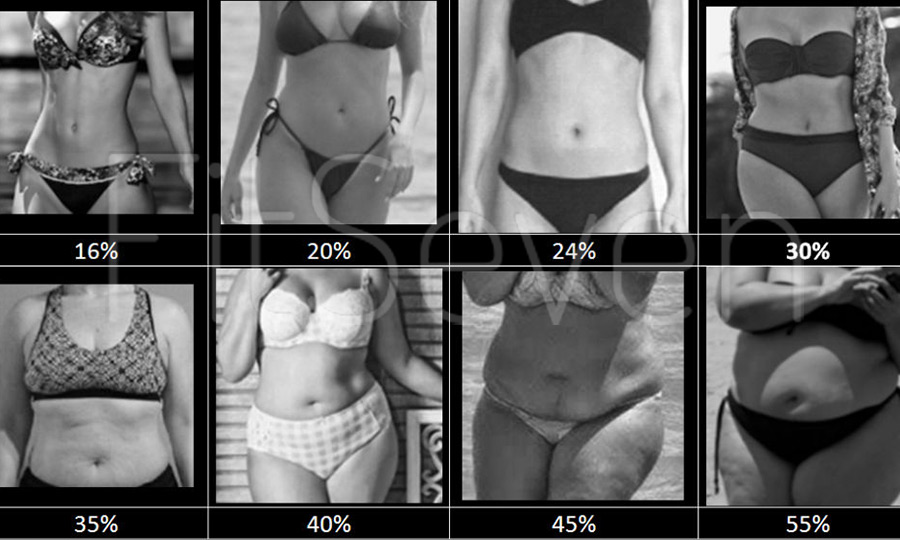
For girls, an athletic physique is characterized by 14-20% body fat, good physical form- 21-24%, average fat level - 25-31%. At the same time, a fat level below 10% is extremely dangerous for female body and leads to the cessation of the menstrual cycle.
How to calculate your fat percentage?
Calculating the percentage of body fat is simple - to do this, you need to divide the fat mass in the body by the total weight. For example, if you have 10 kg of fat at a weight of 70 kg, then the percentage of fat will be 10/70 = 14.3%. However, the key challenge is knowing exactly how much fat you have.
There are several methods for determining the amount of fat in the body. Only one of them - hydrostatic weighing - is direct and shows the real figure for your body. All other methods are indirect and based on comparison of statistical data.

hydrostatic weighing. The only measurement method that shows the real amount of fat tissue in the body. It is based on the simplest laws of physics - first the body is immersed in a bath of water (in this case, the volume of “flowed out” water is equal to the volume of the body), then the volume is compared with the weight and the percentage of fat is calculated.
Electronic body analysis systems
Action electronic systems Body composition analysis is based on passing very weak and harmless electrical currents through the tissues and then analyzing the speed of passage and the percentage of signal loss. Adipose tissue delays the signal, while water and muscles conduct it almost entirely.
Note that such systems do not determine the fat content specifically in your body, but only compare the indicators with average figures and show an approximate result. Their error depends both on the number of measuring electrodes and on temperature, the presence of food in the stomach and other factors.
Scales with body analysis

Floor scale with body analysis is one of the least precise methods measuring body fat content. By sending a weak current through one leg, the scales “wait” for it on the other and determine the percentage of losses. However, the resulting signal loss can be caused by a variety of reasons.
The only way to use such scales is to track the trend - let the number lie, but what is important is its increase or decrease over time. The presence of handles reduces the error and allows you to determine the fat content more accurately - however, such scales are quite expensive. 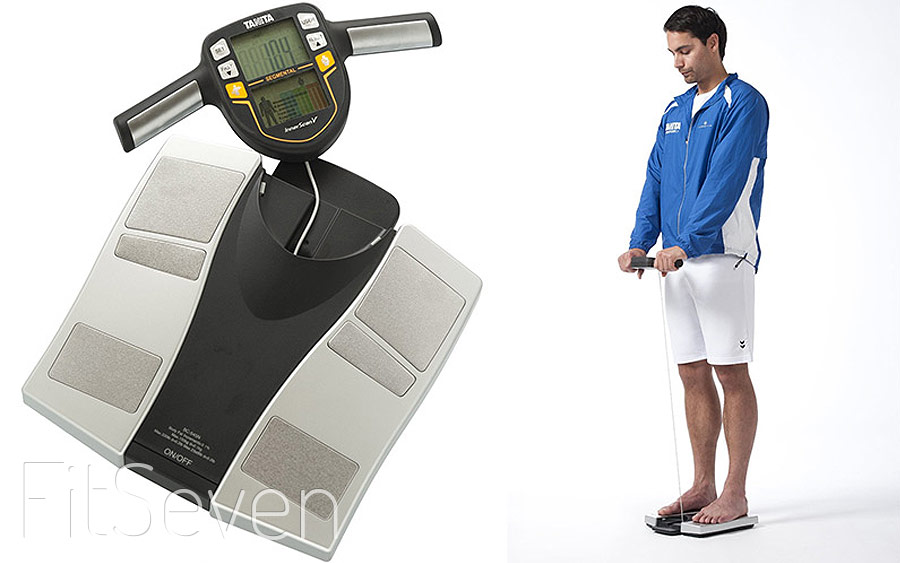
Measuring body fat with a caliper
The measurement method consists of measuring the folds of subcutaneous fat with a caliper-like device (“caliper”) and comparing the result with a table. The table contains a comparison of the thickness of the fat fold in millimeters and the approximate percentage of body fat.
Caliper measurements are more accurate than measurements electronic scales, since the thickness of the belly fat fold is directly related to the total amount of fat in the body. An important advantage of the method is that an ordinary caliper can also serve as a caliper at home. 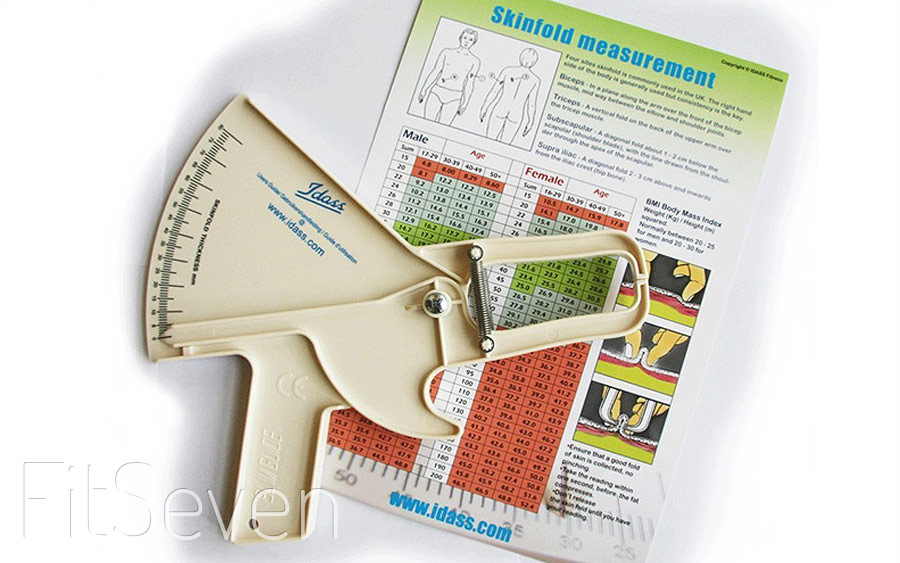
How to measure fat level with a caliper?
The technique of taking measurements to determine the level of fat using a caliper is simple - you need to stand up straight, find a point 10 cm to the right of the navel at a height of 3-4 cm from the edge of the protruding femur, pinch the skin and fat at this place, then measure the thickness of the clamp with a caliper.
The measurement result in millimeters and your age are compared with the table below - at the intersection there is a number showing the predicted fat content in your body. The table also shows whether the indicator is in the high, medium or low zone.
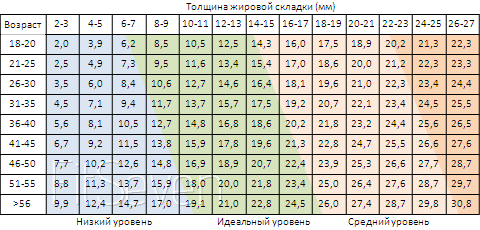
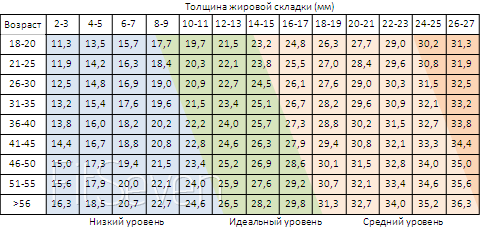
To calculate your body fat percentage, you need to know your physical fat mass. The only direct method for determining this figure is weighing in a special bathroom; all other methods are indirect and may contain significant measurement errors.
Let's explore what it is normal percentage body fat
Previously, men (and even some women) set their main goal to build muscles. But times are changing and now the main thing is “lean” mass, namely getting rid of fat mass in order to maximize muscle manifestation. Just think of Brad Pitt in Fight Club or Cristiano Ronaldo at any point in the last ten years. Pronounced muscles, not fat tissue.
A similar figure - lean body mass, without excess deposits - has recently become the main goal of trainers and visitors gyms. But even if you are not striving for such pronounced muscles, it is worth finding out what percentage of body fat is normal and whether you need to change it, since this amount is one of the main indicators of the health of the body.
“Having a normal percentage of body fat reduces the risk of developing a variety of diseases,” explains Dr. Luke Powles from medical center Bupa's Crossrail in London.
“It has been proven time and time again that increased content fat in the body leads to increased cholesterol levels and blood pressure, which are risk factors for the development cardiovascular diseases. Also similar condition may cause certain types of cancer and diabetes. In men, high body fat leads to erectile dysfunction.
But the percentage of body fat to muscle mass should not be too low, since underweight also leads to the development of a number of diseases.”
How much fat should you ideally have? For men aged 20-39 years old, the norm of body fat varies from 8 to 20%, for men aged 40-59 – from 11 to 22%. Now it’s much easier to find out your body fat percentage: smart scales, pocket scanners and fitness trackers can easily provide all the information about your body composition. For conservatives (or budget-conscious) there is also an option - a caliper.
Before you start losing fat, it's worth learning a little about the biological processes behind it. Let's start with the two types of fat: essential and stored.
Essential fats
Essential fats are fats that are essential for healthy and normal functioning our body. For men, this is about 3% of total body weight. Without essential fatty acids such as omega-3 from oily fish, nuts and seeds, the body is not able to process such useful material, like vitamins A, K and D, which are responsible for immunity, blood clotting and calcium absorption. Fat is also necessary to protect internal organs and regulate internal temperature bodies.
Accumulated fat
Another type - accumulated - is the result of excess calories consumed. When we eat, calories that are not immediately used for functioning (such as providing energy for breathing or storing heart rate) are converted into triglycerides, which make up stored fat. Frequent excess calories, which cause fat accumulation, lead to weight gain. On the other hand, a repeated calorie deficit forces the body to use stored fat mass as energy, depleting reserves and leading to weight loss.
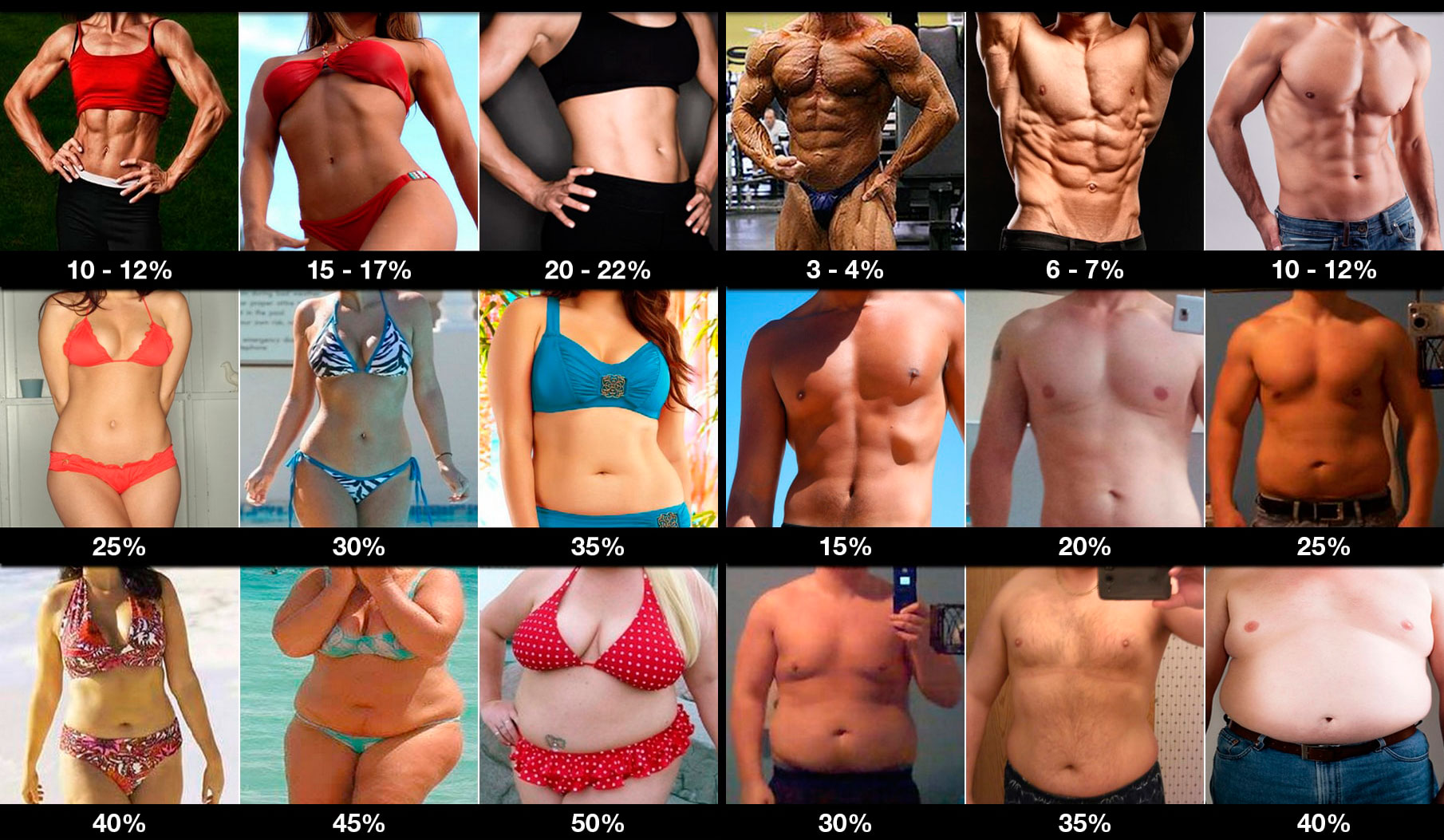
Body fat percentage
Simply put, fat is unused energy that is life-threatening. Its percentage in the body is the ratio of fat mass to total body weight. Returning to the question of what percentage of fat a person should have in the body, it should be noted that this number is influenced by many factors, such as height, gender and heredity. A "healthy" percentage for men aged 20 to 40 is generally considered to be no less than 8% and no more than 20%. U healthy woman in the same age group The fat percentage should be between 15% and 31%. These figures are based on November 2015 data from the Royal College of Nursing.
Table of body fat percentage for men of different age groups
Most people can be guided by these indicators, but it should be remembered that the table does not take into account everyone’s individual fitness goals. Bodybuilders typically aim for ultra-lean muscle mass and a body fat percentage of no more than 5-8%. Cyclists and gymnasts are among the leanest athletes and typically have between 5 and 12% body fat. In order to look as prominent as possible, the indicator should be from 5 to 10%.
BMI and body weight
Body fat percentage – best indicator health. It is better suited for determining the constitution than the aging body mass index (BMI) or simply weighing. Weight may vary significantly depending on hormonal surges, time of day, amount of food eaten and drunk before stepping on the scale.
If you are very tall and have significant muscle mass, your BMI will likely put you in the overweight or even obese category. The problem is that BMI was developed in 1832 by Belgian mathematician Adolphe Quetelet to identify the average person (determining how weight increases with height), not to identify underweight or obesity.
In the 1980s, BMI was adopted as a useful tool for determining life expectancy, and has been the bane of muscular people ever since. Often, due to BMI, young people cannot get into the police and other service-oriented physical state structures, since they still use this indicator for admission. However, by measuring your body fat percentage, you are measuring the amount of fat mass, rather than getting an estimate based solely on height and weight.

